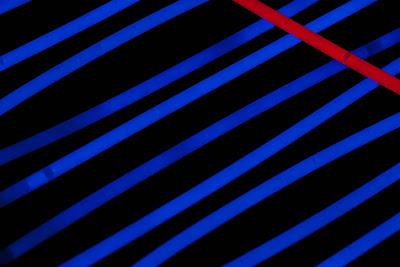One of the major changes in my approach to photography that this course has sparked has been a new interest in how light interacts with matter, in Assignment 1 several of the images used the reflective or transmittive properties of light, both artificial and natural. In the image groups I have created so far for this assignment, I have used natural transmitted light in the autumn leaf sequences, natural reflective light in the market, artificial constant light in the glass sequences, and a little flame in the Church/Glass sequences. The chemical lights would add a new dimension, rather than illuminating my subject with light, my subject would be the source of the light.
To get started I broke 100 chemical lights and arranged them into the individual colours to see what my pallet was going to be:
As best as I could tel the colours available were Blue, Violet, Magenta, Red, Yellow and Green - so all the primary colours and two of the secondary, plus Magenta, enough to create the contrasts I needed. First for fun I threw them in a pile, a kind of colorful pick-up sticks game
Also in a bundle
I then moved on to try and create some simple colour contrasts and immediately ran into a major problem - with all colours present the camera did a good job on white balance, with only 1 or 2 colours the camera was lost. None of the presets worked and the question formed, how to set a manual white balance. Grey card was not going to work, I tried to use a bundle of sticks to illuminate a card, but the light level was far too low. Even with a large number of sticks the exposures were from 1s-30s. Finally I took an equal number of each colour mixed them randomly and took the following shot
From this image I set a manual white balance and stuck with that for the rest of the shooting. Even after this, many of the following shots needed manual modifications to white balance in Lightroom. I tried to be as faithful to what I saw when shooting, but some subjectivity is inevitably included.
All of the shots were taken with my camera on a tripod with a macro head and macro rail attached. Lens choice was either 100mm macro or 24-105mm zoom for the wider angle shots. The camera was tethered to my computer and I shot from the desktop using liveview previews of the compositions. Other than the screen glow all other lights were turned off and I took the photographs after nightfall. I used a sheet of black felt as the background. The light sticks were either placed flat on the felt or wrapped in a rubber band and held in a Wimberly macro clamp (called a "Plamp") - pictured below. These clamps are relatively inexpensive and allow very precise placement of subjects in their jaws, perfect for this task.
The rest was just composition and having fun with different arrangements - although the whole process took around 4-5 hours, just for shooting - a couple of beers supplied some creativity.
Complementary Colours
Red-Green - Random Pile
Red-Green - "Fireworks"
Yellow-Violet - Receding
Red-Green - Closeup
Similar Colours
Red-Purple - Stripes
Yellow-Green - Curves
Yellow-Green - Closeup
Pink-Red - Twisted in Heidi's Hands
Contrasting Colours
Red-Blue - Plaid
Red-Blue - Plaid Closeup
Yellow-Blue - Closeup
Red-Blue - Haze
Colour Accent
Blue-Red
Blue-Red - Bundle
Blue-Red - Closeup
Combinations
Selecting and grouping these images is the final stage and I have created 3 samples each using a slightly different theme
First of all closeups using bundles mounted on the macro arm. These are dramatic and very strong compositions, however, each image is very similar and the technique used does not vary greatly
Alternatively the next combination uses lines as the driving compositional element, varying colour and composition, but again, too samy
The final group is close to what I might submit for the assignment, it uses the same basic materials, but in very different compositions



























No comments:
Post a Comment